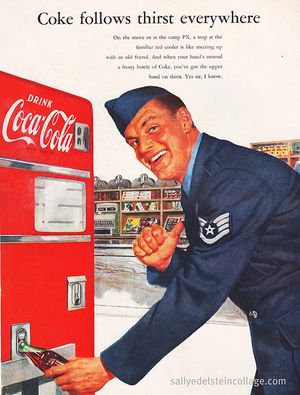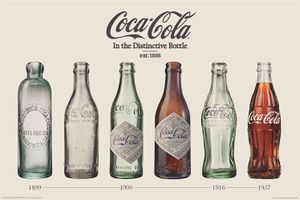Coca-Cola Bottles
COCA-COLA: A PRODUCT OF "CULTURES IN CONTACT
According to the Coca Cola website, there are 112 country specific Coca-Cola webpages for countries in North America, Latin America, Europe, Eurasia, Africa, and Asia Pacific- that’s a huge following! Simply its sheer global expansion and popularity is an example of how cultures share a common interest (liking of Coca-Cola) and therefore share contact through coca cola consumption.
THE EVOLUTION OF THE COCA-COLA BOTTLE
Below is the evolution of the Coca-Cola bottle quoted directly from www.coca-colacompany.com/timeline-the-evolution-of-the-coca-cola-bottle.
1899 - Coca-Cola first bottled under contract in Chattanooga, Tennessee. Coca-Cola President Asa Candler sells the bottling rights for $1. Bottles used at this time are straight-sided Hutchinson bottles with a metal stopper.
1906 – Amber-colored and clear straight-sided bottles with an embossed logo are used by bottlers across the U.S. In 1906, a diamond shaped label is added to make the bottle stand out from competitors.
1915 – The tremendous success and growth of Coca-Cola encourages competitors to try and imitate Coke by offering bottles with slight variations on the trademarked name and distinctive script logo. The now famous Coca-Cola contour bottle is patented in 1915 by the Root Glass Company of Terre Haute, Indiana. The creative brief given to Root called for a bottle that could be recognized when broken on the ground of by touch in the dark.
1923 – With the expanded availability of home refrigeration, the six pack bottle carrier is developed by the Coca-Cola system to encourage consumers to enjoy the beverage at home.
1941 – Thousands of men and women sent overseas. The country, and Coca-Cola, rally behind them. President Robert Woodruff orders that “every man in uniform gets a bottle of Coca-Cola for five cents, wherever he is, and whatever it costs the company.” His vision that Coca-Cola be placed within “arm’s reach of desire” becomes real – from the mid-1940’s until 1960, the number of countries with bottling operations nearly doubles.
1950 – Coca-Cola becomes the first commercial product to appear on the cover of Time magazine. The appearance solidifies Coca-Cola as an international brand. The magazine originally asks to place long-time Company leader Robert Woodruff’s image on the cover, but he refuses, saying the brand is the important thing and Coca-Cola itself should be featured.
1955 – Coca-Cola expands its packaging offering from the standard 6.5-ounce contour bottle to include 10-, 12-, and 26- ounce contour bottles in the U.S., making an important step in giving consumers packaging options to meet their needs.
1957 – Coca-Cola contour bottles are printed with a white label featuring both trademarks, Coca-Cola and Coke. Previously the trademark Coca-Cola had been blown in glass lettering on the bottle.
1960 – 12-ounce aluminum Coca-Cola cans are introduced in the U.S. Early can graphics include an image of Coca-Cola bottle so costumers will recognize it as the same beverage they enjoy from a bottle
1977 – The Coca-Cola bottle is granted registration as a trademark, a designation awarded to few other packages. A previous study showed that less than 1% of Americans could not identify a bottle of Coke by shape alone.
1993 – The 20-ounce PET contour bottle is introduced. The bottle helps distinguish Coca-Cola from other beverages, just as the glass contour bottle had in 1915.
2008 – Coca-Cola is awarded the first ever Design Grand Prix at the prestigious Cannes Lions for the brand’s refreshed visual identity and packaging of the aluminum bottle.
2009 – Coca-Cola introduces the “plant bottle” – 100% recyclable and made with up to 30% renewable, plant-based material
2010 – The 111 Navy Chair debuts at the Salone Internazionale del Mobile. Though partnership with Emeco, the iconic Navy Chair gets a fresh spin, in a new material. Each chair is made from 111 PET bottles diverted from landfills.
2012 – Bottleware by Nendo debuts at Design Tide Tokyo. The collection of bowls is made from recycled glass Coca-Cola bottles, which can no longer be refilled or reused. The form is inspired by the base of the iconic bottle.
2015 – Coca-Cola bottle turns 100. “The perfect liquid wrapper” – Raymond Loewy
"Timeline: The Evolution of the Coca-Cola Bottle." The Coca-Cola Company. Coca-Cola INC, n.d. Web. 26 Nov. 2015. (http://www.coca-colacompany.com/timeline-the-evolution-of-the-coca-cola-bottle/#TCCC)
THE GLOBALIZATION OF COCA-COLA - CULTURES AND CONTACT
According to the Coca-Cola website, there are 112 country specific Coca-Cola webpages for countries in North America, Latin America, Europe, Eurasia, Africa, and Asia Pacific. Simply its sheer global expansion and popularity is an example of how cultures share a common interest (liking of Coca-Cola) and therefore share contact through coca cola consumption.
Coca-Cola was first bottled in 1899 in Tennessee, United States of America (Coca-Cola Company, 2015). By 1941 World War II was in full affect and Coca-Cola became a huge supporter. President Robert Woodruff ordered “every man in uniform gets a bottle of Coca-Cola for five cents, wherever he is, and whatever it costs the company” (Coca-Cola Company, 2015). This order from President Woodruff brought a form solidarity and camaraderie between the men and women across the world who were fighting with the United States against Hitler. When Coca-Cola appeared on the cover of TIME magazine in 1950 as the first product to ever do so, the brand was said to of officially been recognized as an international brand (Coca-Cola Company, 2015). And between the 1940’s to 1960’s, the amount of nations producing and selling Coca-Cola doubles (Coca-Cola Company, 2015).
By 1977 the trademark bottle of Coca-Cola had become so internationally recognized that a study conducted in America “showed that less than 1% of Americans could not identify a bottle of Coke by shape alone” (Coca-Cola Company, 2015). Today the Coca-Cola brand is still one of the most popular brands in the United States as well as the rest of the world, with over 70% of Coca-Cola’s business revenue coming from outside of the United States (Coca-Cola Company, 2015). Some reasons for its marketing success could be their catchy slogans such as “Enjoy” or “life tastes good”. As well, their commercials have always included likeable songs and bright vibrant colours, another way to appeal to the viewer’s attention. No matter where you travel in the world, it is apparent that Coca Cola has spent millions of dollars on mass marketing to make sure that their products are exhibited and available worldwide in nearly every grocery store, restaurant, coffee shop, hotel, mall, and vending machines.
"Timeline: The Evolution of the Coca-Cola Bottle." The Coca-Cola Company. Coca-Cola INC, n.d. Web. 25 Nov. 2015. <http://www.coca-colacompany.com/timeline-the-evolution-of-the-coca-cola-bottle/#TCCC>.
COCA-COLA BRANDING
Coca-Cola is arguably one of the world’s most recognizable brand. With its global availability and popularity, Coca-Cola is a prime example of cultures in contact, as almost the entire world shares a common interest in the product. Coca-Cola capitalizes on its massive popularity by presenting its product in an easily recognizable package, its signature glass bottle. This presentation creates a single common image that comes to mind when considering Coca-Cola. Across the world this bottle is consistent and used in advertisements to promote the product. The company pounces on this global recognition in its advertising, using the similarly recognizable image of Santa Claus in its holiday themed advertisements. Not only does Coca-Cola have their signature bottle in play in these advertisements, so too do they have a (nearly) universally recognizable character promoting their product. Gabriella Kalapos posits that Santa Claus is a character formed out of the gift-givers of various cultures combining into one single persona1 thus the use of such a universal character to promote an already universally recognizable product brings Coca-Cola to the forefront of globally popular brands. The bottle, along with clever advertising by the company’s marketing team allows the product to be recognized and related to any and all cultures around the world.
1 Kalapos, Gabriella. Fertility Goddesses, Groundhog Bellies & the Coca Cola Company: The Origins of Modern Holidays. Toronto: Insomniac Press, 2006, 242.
COCA-COLA - MAINSTREAM MEDIA
Coca-Cola has made numerous appearances throughout film history. From the first silent films, Hollywood blockbusters as well as foreign films, Coca-Cola cinematic presence has been unwavering. Coca-Cola represents and symbolizes “Americana” and its appearance in a wide variety of genres represents America’s pop culture influencing and integrating itself within various cultures. Coca-colas appearance in films acts as both a subtle narrative as well as a reminder of the presence of American culture. “Coca-Cola’s inclusion in movies has happened organically because filmmakers believed Coca-Cola truly belonged in the frame,”[1] One of the first films to have featured Coca-Cola is the 1916 film The Mystery of the Leaping Fish. Coca-Cola has appeared in iconic roles such as in The Gods Must Be Crazy (1980), E.T. (1982) opening can of Coke, and Superman (1978) crashing through a billboard.[2] Furthermore, Coke has made several appearances in international film, a notable foreign film featuring the soft-drink is Jean Luc-Goddard’s French Film Breathless where the protagonist is drinking a bottle of Coca-Cola. As Coca-Cola has become a symbol of American culture, Coca-Cola and its iconic glass bottles have made its way into American film culture. Coke’s representation has since grown from domestic appearances to international film cameos. Coca-Cola’s prevalence in international film and television media indicates how an American cultural item influences and impacts other cultures.
Moye, Jay. Coke Red on the Silver Screen: Exploring the Brand’s Role in Movies. 28 Febuary 2014.
COCA-COLA - WORLD WAR 2
During the Second World War, Coca-Cola became highly involved in wartime politics, leading to its uptake in global markets and surging popularity.
Coca-Cola became a wartime “necessity” due to the support of the brand by the American military, specifically Dwight D. Eisenhower. Robert Woodruff, the president of Coca-Cola had personal ties with General Eisenhower.1 This relationship was fundamental in Coca-Cola becoming both a cultural symbol of American nationalism and a part of the military-industrial complex itself. In 1943, Eisenhower asked Coca-Cola to build plants overseas, to supply soldiers with the beverage. Woodruff famous replied, “every man in uniform gets a bottle of Coca-Cola for five cents, wherever he is and whatever it costs the company”. 1 Coca-Cola sent “Technical Observers” overseas to oversee their operations; they were given officer rank, pay, and uniforms with a special patch. 2
As well as allied propaganda, Coca Cola used its wartime involvement to advertise itself as a lubricant for cross-cultural interactions. In an ad campaign known as ‘the global high sign ad campaign’ Coca-Cola marketed itself as bringing peace and friendship to new people all over the world3.
Footholds secured during WWII enabled the successful international expansion of Coca-Cola. The plants that were created overseas during the war functioned to jumpstart international markets. Coca-Cola doubled its international factories between the 1945-1960. 1
Since then Coca-Cola has become a leading beverage in the world. The success of Coca-Cola is tied to its cultural message: Coke is the drink of ‘winners’, friendliness, modernity, and glamour4. As an affordable consumer luxury, people worldwide could buy a piece of the American superpower status. The rise of Coca-Cola is right at the core of post-WWII globalization of American values. Perhaps also reflecting American values and priorities, Coca-Cola has also become a major contributor to global environmental waste, displacement of traditional foods, and diabetes.
1 History of Coca-Cola | The war and what followed | Coca-Cola GB. (n.d.). Retrieved November 26, 2015, from http://www.coca-cola.co.uk/stories/history/heritage/our-story-1941-1959--the-war-and-what-followed/ 2 Coke and the U.S. troops. (n.d.). Retrieved November 26, 2015, from http://www.coca-colacompany.com/stories/2008/11/coke-and-the-us/#TCCC 3 Coca-Cola around the world, World War II. (n.d.). Retrieved November 26, 2015, from http://www.adbranch.com/coca-cola-around-the-world-world-war-ii/ 4 Coca-Cola: The Pause That Refreshed - The National WWII Museum Blog. (2011, August 30). Retrieved November 26, 2015, from http://www.nww2m.com/2011/08/coca-cola-the-pause-that-refreshed-2/
CONCLUSION
The popularity of the drink can be attributed to capitalist globalization and the spread of American influence during the twentieth century. As the world became better connected after the Second World War, Coca-Cola's rise to product stardom represents the uptake of American values and consumerist culture around the globe.

